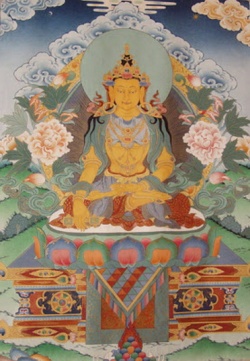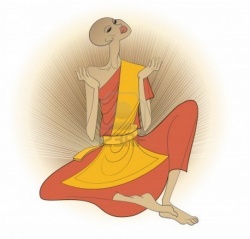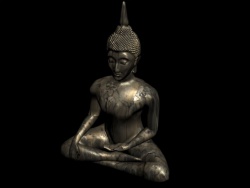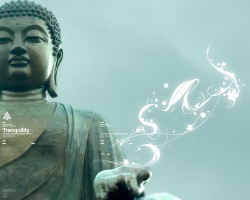Nondual Emptiness Teachings
Posted by: Wei Yu
Why Emptiness?
Emptiness is another kind of nondual teaching. Emptiness teachings demonstrate that the "I," as well as everthing else, lacks inherent existence. The notion of lacking inherent existence has several senses. In one sense, empty things lack essence, which means that there is no intrinsic quality that makes a thing what it is. In another sense, empty things lack independence, which means that a thing does not exist on its own, apart from conditions or relations. A great deal of what one studies in the emptiness teachings demonstrates that these two senses amount to the same thing.
Emptiness teachings are found mainly in Buddhism, but there are some surprising parallels in the work of Western thinkers such as Heraclitus of Ephesus (c. 535–475 BCE) Protagoras of Abdera (480-411 BCE), Gorgias of Leontini, Sicily (485-380 BCE), Pyrrho of Elis (c. 360-270 BCE), Sextus Empiricus (c. 160-210 AD), Marcus Tullius Cicero (106-43 BCE), Marcus Fabius Quintilianus (c. 35-100 AD), Michel de Montaigne, Thomas Hobbes, David Hume, Martin Heidegger, Ludwig Wittgenstein, Hans-Georg Gadamer, Paul Ricoeur, Jacques Derrida, W.V.O. Quine, Wilfred Sellars, Thomas Kuhn, Paul Feyerabend, Donald Davidson, Richard Rorty, Nelson Goodman, Richard Lanham, John D. Caputo, Richard Bernstein and many others.
Lotus
According to Buddhism, when emptiness is realized, peace ensues. One's experience is transformed so that the self, other beings and the world no longer seem like intrinsically compartmentalized objects, distinct and separate from each other. The self and all things are experienced as free.
If the selflessness of phenomena is analyzed
and if this analysis is cultivated,
It causes the effect of attaining nirvana.
Through no other cause does one come to peace.
(The Samadhiraja Sutra)
One who is in harmony with emptiness
is in harmony with all things.
(Nagarjuna, Treatise on the Middle Way 24.14)
How Is Emptiness Nondual?
The most common connotation of "nonduality" is "oneness" or "singularity." Many teachings state that everything is actually awareness; those teachings are nondual in the "oneness" sense in which there are no two things.
But there is another sense of "nonduality." Instead of nonduality as "oneness," it's nonduality as "free from dualistic extremes." This entails freedom from the pairs of metaphysical dualisms such as essentialism/nihilism, existence/non-existence, reification/annihilation, presence/absence, or intrinsicality/voidness, etc. These pairs are dualisms in this sense: if you experience things in the world in terms of one side of the pair, you will experience things in the world in terms of the other side as well. If some things seem like they truly exist, then other things will seem like they truly don't exist. You will experience your own self to truly exist, and fear that one day you will truly not exist. Emptiness teachings show how none of these pairs make sense, and free you from experiencing yourself and the world in terms of these opposites. Emptiness teachings are nondual in this sense.
For those who encounter emptiness teachings after they've become familiar with awareness teachings, it's very tempting to misread the emptiness teachings by substituting terms. That is, it's very easy to misread the emptiness teachings by seeing "emptiness" on the page and thinking to yourself, "awareness, consciousness, I know what they're talking about."
Early in my own investigations I began with this substitution in mind. With this misreading, I found a lot in the emptiness teachings to be quite INcomprehensible! So I started again, laying aside the notion that "emptiness" and "awareness" were equivalent. I tried to let the emptiness teachings speak for themselves. I came to find that they have a subtle beauty and power, a flavor quite different from the awareness teachings. Emptiness teachings do not speak of emptiness as a true nature that underlies or supports things. Rather, it speaks of selves and things as essenceless and free.
Emptiness in Buddhism
According to Buddhist teachings, freedom from suffering dawns when we realize that we ourselves, as well as all things, are empty.
In Buddhism, suffering is said to come from conceiving that we and the world have fixed, independent and unchangeable natures that exist on their own without help from anything else. We expect that there is a true way that self and world truly are and ought to be. These expectations are unrealistic and prevent us from granting things the freedom to come and go and change. We like pleasant things to abide permanently, and unpleasant things to never occur. We experience suffering when we actually encounter comings, goings and change. Suffering often takes the form of anger, indignation, existential anxiety, and even a sense that, as they say in TV sitcoms, "something is wrong with this picture."
But when we deeply realize that we and the world are empty, we no longer have unrealistic expectations. We find peace and freedom in the midst of flux.
What Does Emptiness Mean?
What are things empty of? According to the Buddhist teachings, things are empty of inherent existence.
Being empty of inherent existence means that there is no essential, fixed or independent way in which things exist. Things have no essential nature. There is no way things truly are, in and of themselves. We will investigate the notion of inherent existence in more detail below.
Different Buddhist schools or tenet systems have different ways of characterizing emptiness; they have different ways of helping students reduce suffering. My characterization of emptiness adheres somewhat to the Tibetan Gelug-ba school of Prasangika or "Consequentialist" Madhyamika. The term "prasangika" is Sanskrit for "consequence." The "consequence" designation comes from this school's method of debate and refutation, which follows Nagarjuna's style in his Treatise.
The Dialectical Approach
The Consequentialists do not argue for substantive positions, but proceed dialectically. They argue by drawing out the unwanted and unexpected logical consequences entailed by their interlocutors' positions. The Consequentialist style of refutation is as follows: while in debate over metaphysical issues with an interlocutor, the Consequentialist refutes the interlocutor not by negating the interlocutor's statement with a counter-statement (e.g., that matter exists, not Mind), but by finding an inconsistency or a reductio ad absurdum among the interlocutor's statements. This allows Consequentialism to be positionless with respect to issues, most notably on questions of existence and non-existence.
Imagine a philosopher coming up to a man who is sitting quietly against a tree, and telling the man that the tree truly exists because it is of the nature of Mind, and only Mind really exists. The sitting man is a consequentialist. He doesn't have an opinion on the existence or non-existence of Mind or the tree, and doesn't wish to convince the philosopher of a contrary position; he's just sitting there. So he won't offer a counter-claim or argue that the tree really doesn't exist as Mind. Instead, he will draw out more statements from the philosopher until the philosopher is involved in a contradiction. Or he might show that the philosopher's assumptions entail an absurd, unwanted conclusion. Then he'll go back to sitting against the tree.
The Consequentialist school is the most thoroughgoing of the Mahayana schools in its rejection of any kind of intrinsic nature. Even though it is the school of His Holiness the current Dalai Lama, most of the Dalai Lama's public teachings are about other topics of wider interest. Emptiness teachings can get abstract and subtle, and not everyone is interested in them. But if you do find books in English on emptiness, most of them are likely to be written from the Consequentialist standpoint. You will find a list of these books in the References below.
The Buddhist World
According to the Buddhist emptiness teachings, the world is made up only of things that are "selfless" or empty. Even non-existents are empty. Non-existents would include round squares, the hairs of a turtle, etc., and inherent existence. Existents are divided into two classes, compounded things and non-compunded things.
Compounded things are said to disintegrate moment-to-moment, in a way analogous to aging. They are impermanent in this sense. Compounded things have pieces or parts and are produced from combinations of other factors. Compunded things include physical objects, colors, shapes, powers, sensations, thoughts, intentions, feelings, persons, collections, and states of being. These various things fall under the categories of Form (colors, shapes and powers), Consciousness (the sensory modalities and thinking processes), and Compositional Factors (collections and states of being).
Non-compounded things include do not distintegrate moment-to-moment. In this sense, they are said to be "permanent." There are two kinds of "permanent" existent. There are "occasional permanents," which come into existence and go out of existence. These include, for example, the space inside the cup and the emptiness of the cup. Even though the cup is compounded and consists of parts (such as the rim, the handle, the walls, etc.), the space inside the cup and the emptiness of the cup are not compounded and do not consist of parts. Also, the emptiness of the cup and the space inside the cup stop existing when the cup stops existing. There are also "Non-occasional permanents," such as emptiness in general and space in general. These are the referents of general concepts, and exist as long as any objects or relations exist.
For the student of emptiness, it is not important to remember or utilize this scheme or employ these categories in one's day-to-day use. What is important is to learn the lessons taught by this scheme:
According to the Buddhist world-view, everything that exists is said to be empty
For each thing, there is also the corresponding emptiness of that thing, because to exist is to be empty
Inherent existence falls under the category of non-existent things
This last point is especially important when it comes to meditating on emptiness. When you meditate on emptiness, what you actually look for is inherent existence. Instead of finding inherent existence, you will find the lack of inherent existence. This lack itself is emptiness.
Emptiness and Dependent Arising
According to the Mahayana paths of Buddhism that emphasize the notion, emptiness is what the early Buddhist sutras were pointing to when they presented the notion of pratītyasamutpāda (Sanskrit) or paticcasamuppāda (Pali), namely "dependent arising":
There is the case where a disciple of the noble ones notices:
When this is, that is.
From the arising of this comes the arising of that.
When this isn't, that isn't.
From the cessation of this comes the cessation of that.
(Anguttara Nikaya X.92; Vera Sutta)
Centuries later, Nagarjuna (2nd century C.E.) became the preeminent expositor of emptiness teachings. His Mūlamadhyamakakārikā (Treatise on the Middle Way) is today considered the most profound and sophisticated exposition of emptiness in Buddhism. The text provides scores of arguments for the conclusion that to propose any kind of inherent existence or metaphysical essence involves the proponent in logical contradictions and incoherence. Chapter 24 actually contains two specific verses that characterize the notion of emptiness itself:
Whatever is dependently co-arisen,
That is explained to be emptiness.
That, being a dependent designation,
Is itself the middle way. (Treatise, 24.18)
Something that is not dependently arisen,
Such a thing does not exist.
Therefore a nonempty thing
Does not exist. (Treatise, 24.19)
In verse 18, Nagarjuna sets up a three-way equivalence:
emptiness : dependent arising : verbal convention
and identifies this equivalence with the Middle Way. The Middle Way is a form of nonduality that is free from the dualistic opposites of essentialism and nihilism. Even emptiness itself is characterized as being empty. It is empty because, instead of having the inherent nature of being dependent arising, it is merely "explained to be" dependent arising.
In verse 19, Nagarjuna states that whatever exists, is in some sense dependently arisen, that is, empty. If something is not dependently arisen, then it is not empty. If it is not empty, then it does not exist. And of course even things we would normally consider as non-existent, such as unicorns and round squares, are also empty.
Conventional Existence
So how do things exist if they don’t exist inherently? According to the Buddhist teachings, things exist in an everyday, non-inherent, dependent way. Our mode of existence is dependent on many things, such as the causes and conditions that give rise to us, the components that make us up, and the ways we are cognized and categorized. According to the teachings, we are not separate and independent entities, but rather we exist in dependence on webworks of relations and transactions.
For example, we can say that a bottle of milk exists in a dependent, conventional way because you can go to the store, lift the bottle of milk off the shelf, pay for it, and bring it home. It exists in dependence on its surroundings, its having been manufactured, and in relation to the actions of the store employees and yourself. The bottle of milk is not found to exist independently of these things.
It is taught that all things are empty and dependent like this. That includes people and all other living beings, as well as consciousness and unconsciousness; pleasure and pain; time and space; cause and effect; good and bad; logic and math; language, meaning and reference; art, commerce and science; planets, boulders and bridges; unicorns and Sherlock Holmes; energy, thoughts, feelings, and bodily sensations. Whatever exists is said to exist conventionally, but not inherently.
Emptiness Itself is Empty
Even emptiness is empty. For example, the emptiness of the bottle of milk does not exist inherently. Rather, it exists in a dependent way. The emptiness of the bottle of milk is dependent upon its basis (the bottle of milk). It is also dependent upon having been designated as emptiness. As we saw above, this is alluded to in Nagarjuna’s Treatise, verse 24.18.
Understood this way, emptiness is not a substitute term for awareness. Emptiness is not an essense. It is not a substratum or background condition. Things do not arise out of emptiness and subside back into emptiness. Emptiness is not a quality that things have, which makes them empty. Rather, to be a thing in the first place, is to be empty.
It is easy to misunderstand emptiness by idealizing or reifying it by thinking that it is an absolute, an essence, or a special realm of being or experience. It is not any of those things. It is actually the opposite. It is merely the way things exist, which is without essence or self-standing nature or a substratum of any kind. Here is a list characteristics of emptiness, to help avoid some of the frequent misunderstandings about emptiness, according to the Buddhist Consequentialists:
Emptiness is not a substance
Emptiness is not a substratum or background
Emptiness is not light
Emptiness is not consciousness or awareness
Emptiness is not the Absolute
Emptiness does not exist on its own
Objects do not consist of emptiness
Objects do not arise from emptiness
Emptiness of the "I" does not negate the "I"
Emptiness is not the feeling that results when no objects are appearing to the mind
Meditating on emptiness does not consist of quieting the mind
Inherent Existence
Inherent existence is the kind of existence we uncritically think things have, existing under their own power, without help from anything else. Our sense that things exist in this way is the root of our suffering, according to the Buddhist teachings. We have a sense of this inherency partly due to how we think of language. We think that words are labels pointing straight to pre-formatted, already-individuated things in the world outside of language or cognition. This tendency to feel inherency can even be intensified if we follow essentialist philosophies such as Platonism or materialist realism, which hold that things exist according to their own essential nature, independent of anything else. Our natural tendency to feel this inherency is the root of suffering, according to the emptiness teachings. Actually, being able to locate and isolate this sense of inherent existence in yourself is good news. The more clearly you can grasp the sense of inherent existence, the more powerfully you will be able to realize emptiness when you do your meditations.
What does the sense of inherent existence feel like? We will say much more about this later, but briefly, it feels like something is really there, just like that, being what it really is. You've had a very definite sense of inherent existence if you've ever wondered whether something or someone has been given the "correct" name! Or could it perhaps have been given the wrong name??
According to the emptiness teachings, inherent existence is the kind of existence that things do not have. Things actually lack inherent existence, because they exist as dependent arisings. This dependency is the lack of inherent existence, which in turn, is their emptiness.
The relation between inherent existence, emptiness and dependent arising can be seen through the translation of the Sanskrit or Pali terms for depending arising: pratītyasamutpāda (Sanskrit) or paticcasamuppāda (Pali). The Sanskrit components are individually translated as follows:
Pratītya = Meeting, Relying or Depending + Samut = Out of + Pad = To go, to fall
Notice the three English terms for Pratītya, Meeting, Arising, and Depending. These have been given three different kinds of meanings by the consequentialist writers (see H.H. the Dalai Lama, 2000, pp. 35ff in References), so as to cover all the variations of dependent arising. These kinds of dependence are explained as follows:
Thumbnail of the Inherent Existence chart
MEETING - The coming together of causes and conditions in time. In Western philosophical terms, this might be referred to as causal depedency. The cessation of cause comes into contact with the onset of effect within a network of supporting conditions. Examples would include one billiard ball striking another, or the sperm and ovum coming into contact at human conception. Because of uncritically thinking that things and people exist inherently, we can sometimes be surprised by the effects of the "Meeting"-style dependent arising. An example would be the surprise at the aging process if we see someone for the first time after a long absence. This is the least subtle of the three types of dependent arising.
RELYING - The way a thing depends on its pieces and parts. In Western philosophical terms, this might be referred to as mereological depedency. The pieces and parts of an object are sometimes called its "basis of designation." According to the emptiness teachings, we would see roots, a stalk, branches and leaves, and based on this, designate the object as a "tree." These various parts are the tree's basis of designation. Being a tree is dependent upon the basis of designation. The tree cannot be said to exist if its basis of designation did not exist. For example, if you have a car in the parking lot over a long period of time, and vandals come and steal pieces here and there over several months, there will come a certain point at which there won't be enough parts for you to call it a car. This is how the car depends upon its pieces and parts, or its basis of designation. Even though this seems reasonable if we think about it like this, it's never theless easy to think that the true car exists in a way apart from the basis of designation, as though there were a "true car" that existed in an ideal realm of some sort. This sense that the car exists without depending on its basis of desgination is the sense of the inherent existence of the car. This is more subtle than "Meeting"-style dependence.
DEPENDING - The way a thing depends on being designated by convention, language, or cognition. In Western philosophical terms, this might be referred to as conceptual depedency. Did Mount Everest exist before it was named? Did sub-atomic particles exist as such before they were ever thought of? Would a "rose by any other name" still be a rose? We look at the shape, size and structure of a natural formation of the earth, and call it a "mountain." According to the Consequentialist emptiness teachings, we would say that the basis of designation (formations of earth) existed, but the "mountain" as such did not exist until it was designated by the process of convention and cognition. According to emptiness teachings, it makes no sense to say that something exists if it was never designated or cognized. Nevertheless, it seems to us that things are always there regardless of cognition, and that cognition is a process of mere neutral discovery of what was pre-formed and present all along. This feeling of independence from designation or pre-formed existence is not only an easy feeling to get hold of, it might even seem like common sense to most people. This is another kind of sense of the inherent existence of things. But the emptiness teachings question this. This critique, this "Depending"-style of dependency (as opposed to the "Meeting" and "Relying" types of dependency) will be familar to those who have studied Advaita-Vedanta, Mind-Only Buddhist teachings, or the philosophy of Idealism. The emptiness teachings are not themselves a form of Vedanta or idealism (because emptiness teachings posit that physical objects do exist externally and physically), but they agree with the views which hold that uncognized objects do not exist. This is the most subtle of the three types of dependent arising.
According to Buddhism, anything that exists exists conventionally, through the network of dependent arisings, that is through Meeting, Relying or Depending. Even emptiness exists in this way. But we think and feel that things exist without these dependencies. For something to inherently exist, it would have to exist without any dependencies at all. It would exist without Meeting, Relying or Depending. It is the job of emptiness meditation to find inherent existence, to ascertain whether it exists as we feel it does.
Other terms for inherent existence, gathered from Buddhist and Western sources, would include the following:
the reality of the thing irrespective of culture or language or human consciousness
objective existence
independent existence
true essence
Platonic essence
real existence
ontological existence
the thing as it really is
the thing in-itself
the is-ness of the thing
beingness
actuality
thinghood
perseity
self-sufficient being
self-inclusive being
essential being
instantiation in reality
subject of ontological commitment
the thing’s entitification
the way it really is, regardless of what anyone thinks
the reality of the thing as opposed to its appearance
what science will eventually discover the thing to be
the way God intends the thing to be
"it is what it is"
"it’s like that, 'cause that’s the way it is" (as the rappers Run DMC used to say)
Compassion and Emptiness
Compassion facilitates the realization of emptiness. Although realizing emptiness is said by Buddhist Consequentialists to be the key to the end of suffering, it nevertheless occurs in context. It is not the first thing one learns. In many Buddhist contexts, there is a teaching emphasis on the importance of developing compassion before learning the emptiness teachings. Compassion in these contexts is explained as the spontaneous and sincere wish to help other beings alleviate suffering. Having this wish not only increases one's own joy, but also the depth of one's insight. Emphasizing compassion early on serves as a preventive measure against two ways to go wrong with the emptiness teachings.
Compassion moves the practitioner beyond a merely memorized or intellectual understanding of the emptiness teachings. Compassion helps one's realization become global and holistic.
Compassion is an antidote to learning the emptiness teachings for selfish, egocentric reasons. When one engages in a difficult dialectic like the emptiness teaching for selfish reasons, the result is counterproductive. Emptiness teachings are very subtle. The most common side-effect of misunderstanding emptiness is a crippling sense of nihilism. A nihilistic outlook makes joy, compassion and emptiness very difficult to realize. One doesn't experience an increase in joy and a decrease in suffering. Instead, one experiences a stiffening of the mind and a closure of the heart. But compassion opens the mind and heart. It allows one to "get out of the way." It makes the emptiness teachings easier to understand, easier to realize holistically, and easier to integrate into one's life. Compassion enables the realization of emptiness.
Realizing emptiness facilitates compassion. The effects run the other direction too. A greater understanding of emptiness enables greater compassion. The more strongly one realizes that one's self and other selves are empty of inherent existence, the less one experiences an essential distinction between one's self and another. It becomes harder to place one's own happiness above that of others. It becomes easier to act in such a way that others are benefitted, not just one's self.
Contextual clues. There is a clue to this traditional placement of emptiness later in the learning stream. In the various lists of Buddhist spiritual virtues called "perfections" or "paramitas" (Sanskrit), there are 6 or 10 items. The "perfection of wisdom" refers to the realization of emptiness or the lack of an essential self. But the perfection of wisdom is never the first item in these lists! It is usually number 4 or number 6. Depending on the list, the perfection of wisdom is preceded by the perfections of: generosity, virtue, renunciation, discipline, patience, tolerance, diligence, and one-pointed concentration.
For example, here is a Theravada list from the Pali Canon of Buddhist scriptures:
Dāna: generosity
Sīla: virtue, morality, proper conduct
Nekkhamma: renunciation
Paññā: wisdom, insight
Viriya: energy, diligence, vigor, effort
Khanti: patience, tolerance, forbearance, acceptance, endurance
Sacca: truthfulness, honesty
Adhiṭṭhāna: determination, resolution
Mettā: loving-kindness
Upekkhā: equanimity, serenity
Here is a Mahayana list:
Dāna: generosity
Śīla: virtue, morality, discipline, proper conduct
Kṣānti: patience, tolerance, forbearance, acceptance, endurance
Vīrya: energy, diligence, vigor, effort
Dhyāna: one-pointed concentration, contemplation
Prajñā: wisdom, insight
I find it interesting that the Mahayana tradition (Nagarjuna's tradition) places more emphasis on the importance of realizing emptiness, and also locates its paramita later in the list, with more perfections before it.
How to Realize Emptiness
So how does one actually realize that all things, self and world, are empty? In a nutshell, the realization of emptiness of an object is accomplished through trying to find and validate that object's inherent existence. One narrows down the options and looks everywhere where the object's inherent existence might be found. What happens is that one fails to find inherent existence. What one finds is the simple lack of inherent existence. This lack is the thing's emptiness.
According to the Buddhist path, one trains to stabilize the attention, abandon harmful actions, take up helpful actions, generate patience and compassion, and meditate on the nature of self and other. These various activities are integrated together to assist the practitioner in generating the insight that things are empty. Emptiness can be realized much more quickly this way than if the person began from scratch with emptiness studies themselves. Realizing emptiness is holistic and not merely an intellectual event. Therefore, a compassionate heart is said to enable the patience, spirit of generosity and flexibility of mind and that are required by the very subtle and tricky emptiness meditations.
The form of Buddhism that places the most emphasis on emptiness meditation is probably the Prasangikga Madhyamika. Once the practitioner has the spontaneous desire for compassion and a yearning to hear the emptiness teachings, then the traditional teacher will begin.
There are several stages in the study of emptiness, which are integrated into much of the Buddhist path itself:
Learn valid establishment – You learn the conventional ways that phenomena are established, i.e., how belief in things is justified. In Buddhism, this can be by learning the Buddhist teachings themselves. They can include teachings on cause and effect, psychology, epistemology, karma, interpersonal relations, compassion, the development of attention and analytical skills. Learning valid establishment prevents the investigator from falling into nihilism, which is the denial of conventional existence along with the denial of inherent existence. Emptiness meditation saves conventional existence, and refutes only inherent existence.
Ascertain the object of refutation – You concentrate to get a strong sense of inherent existence. In this preparatory stage, you familiarize yourself with the difference between conventional existence (which exists, and which is demonstrated by valid establishment) and inherent existence (which we feel exists, but which the meditations prove does not exist). According to the Buddhist teachings, this is the issue in a nutshell, and this is the most challenging stage. Ascertaining the object of entailment can actually require months go get clear about. But the clearer you are on what inherent existence must be, the more able you will be to recognize it should you actually find it in the meditations later, and the more thorough your realization will be.
Determine the entailment – You familiarize yourself with the overall logic of emptiness meditation. The logic is as follows: "Either things exist inherently or they don’t. If things have inherent existence, I should be able to find inherent existence by looking everywhere. But I can’t find inherent existence; I find only its absence, its non-existence. Therefore it doesn’t exist."
Back to top
In the case of the inherent existence of my self, the logic would go as follows:
My self either has inherent existence or it is empty.
If my self has inherent existence, I should be able to find it by looking everywhere it could possibly be.
I have looked everywhere the inherent existence of my self could possibly be, and cannot find it anywhere.
Therefore, my self is empty.
Conduct the emptiness reasonings – These are the meditations themselves. They are called "reasonings" because they involve inference and entailment. They involve a form of logic, and are often thought of as a form of “analytic meditation.” You go through the steps of the emptiness reasonings in a full-fledged, holistic way, trying to put yourself fully into each stage. There are many kinds of emptiness reasoning. One of the simplest to understand is Chandrakirti’s Sevenfold Reasoning. It is easier to learn the stages of the reasoning by applying it to something neutral, such as a car. When the steps are familiar, you apply them to your self, where they are likely to have a greater effect, and the realization will prove to be more intense. The following is an overview of Chandrakirti’s Sevenfold Reasoning, as applied to a chariot:
Introduction: If the chariot exists inherently, I will be able to find it somewhere in or around its parts.
Is the inherently existent chariot exactly the same as its parts? No, I don't find the inherently existent chariot as equal to its parts. Instead, I find its absence, its nonexistence.
Is it totally different from its parts? No, I don't find the inherently existent chariot apart from its parts. Instead, I find its absence, its nonexistence.
Is it dependent upon its parts? No, I don't find the inherently existent chariot as dependent upon its parts. Instead, I find its absence, its nonexistence.
Is it such that the parts are dependent upon it? No, I don't find the inherently existent chariot such that its parts are dependent upon it. Instead, I find its absence, its nonexistence.
Is it the possessor of its parts? No, I don't find the inherently existent chariot as the possessor of its parts. Instead, I find its absence, its nonexistence.
Is it the mere collection of its parts? No, I don't find the inherently existent chariot as the collection of its parts. Instead, I find its absence, its nonexistence.
Is it the mere shape of its parts? No, I don't find the inherently existent chariot as the shape of its parts. Instead, I find its absence, its nonexistence.
Conclusion: Therefore the chariot doesn’t exist inherently. It is empty, existing not inherently, but conventionally only.
For a more detailed look at Chandrakirti’s Sevenfold Reasoning, see "Emptiness Meditation - Another Kind of Self-Inquiry"
Review the relation between emptiness and valid establishment – You reflect on how the emptiness of your self and the emptiness of other beings and things in the world allows all of these existents to move, change, and interact with each other. If things had fixed and independent nature, as we often feel they do, then they would not be able to change. For example, if a tree had an essential nature as something containing 106 branches and 2,196 leaves, then if it lost even one leaf, it would be definition not be that particular tree any more. If we, for example, had a fixed nature as a person with just these physical and psychological characteristics, then we could never become happier more mature, or more slender without violating these characteristics and becoming by definition another person.
Ascertaining the Object of Refutation
This step is pivotal, because until we identify what we're planning to refute, our meditations will be operating blindly. They won't hit the target. We will be refuting the wrong thing, which will lead to either eternalism or nihilism. This step is also very subtle, and can take months.
Ascertaining the object of refutation means to become very clear about our conception of inherent existence. We know from hearing the teachings that nothing actually does exist inherently. But we think things do exist inherently. It's only by focusing on the conception of inherent existence that we can direct our meditations so as not to refute too little (and leave some inherent existence un-refuted, leading to essentialism), and not to refute too much (and refute some aspects of conventional existence, leading to nihilism). Just how does ascertaining the object of refutation work? As follows:
We examine our feelings and thoughts to isolate our conception of inherent existence (explained more below).
We use our conception of inherent existence as a pointer. This pointer leads us to a sort of claim that the self and other objects seem to be making. They seem to be claiming to exist on their own, independently from everything else. Even before doing the emptiness meditations themselves, we know from hearing the teachings that nothing is supposed to exist in this way. These objects are making a false claim, and now we are able to see this false claim up close and clearly. We have confidence that our meditations will be successful, since the teachings tell us that they have been proven to work for generations of meditators.
Armed with our confidence and clear view of the claim of inherent existence, we disprove the claim using the emptiness meditations. We demonstrate to ourselves beyond a shadow of a doubt that the claim is false and unwarranted. This step is the realization of emptiness. It occurs first inferentially, then directly.
We experience the aftereffects of the realization, in which our tendency to feel the conception of inherent existence diminishes until it is eradicated. This is the end of suffering.
The Experience of Emptiness
Experiencing self, other and world as empty is to joyfully experience one's place in a light, free, open-ended, interpenetrating webwork of relations and dependencies. Lightness and joy come from no longer feeling as though reality has or needs a foundation. One no longer suffers from existential commitments, yearnings, and anxieties. Life and death are freed up. Nothing seems ultimately stiff, frozen, apart, separate, or unchangeable. There are no more conceptions of an inherently existing self that exists on its own yet needs to be defended, propped up, aggrandized, and pleasured forever. There are no more conceptions of a metaphysical ground underlying existence that can fulfill you if found or frustrate you if not found. Anxieties pertaining to objectivity and ultimacy have ceased. This opens the heart to the radical contingency of all beings, and brings on the sweet, precious desire and commitment to see them free from suffering as well.
Experience becomes holistic and open-textured, like a web with content as well as a periphery. A spider web and Indra's Net are traditional examples. One never stands apart from the web beholding it from somewhere else. Instead, one has a deep recognition of one's self and one's viewpoint as contingent and dependent on weblike aspects and relations. The web changes whenever something new, whether coarse or subtle, enters at any point. The new element enters by becoming contextualized by the web. At the same time, all the elements of the web are recontextualized to at least some tiny extent by the new element. Nothing is experienced as standing alone, granular, lump-like, or disconnected from other things.
The experience of self and world as empty deepens over time. One familiarizes oneself increasingly with emptiness and its many effects and ramifications, which include compassion. According to Buddhist teachings, realizing and living emptiness is closely related to the classic spiritual desiderata or "paramitas" (Sanskrit). Specific lists differ, but a common Mahayana list of the paramitas with ten members is: generosity, morality, patience, perseverance, concentration, wisdom, method, wishes, power, exalted or perfect (omniscient) wisdom. Number six in the list is the wisdom of emptiness/dependent arising. This is the insight that neither the self nor anything else has a fixed, permanent, foundational, non-contextual or independent essence. The Buddhist practitioner practices all the virtues. Each one helps deepen the others. Numbers (1) - (5) serve as causes and preparation for (6); and (6) serves as a cause for the deepening of the others. Numbers (1) - (5) prepare the mind the the subtle and powerful realization of (6). Number (6) allows the practitioner to practice (1) - (5) without greed, aversion, clinging or objectification.
In the Mahayana schools of Buddhism, one continues this process until full Buddhahood is attained, which can take eons. According to the Tibetan Gelug-ba tradition, there are levels and layers, which one is able to pass through primarily by meditating on emptiness. It is possible to reach freedom from suffering in one lifetime, but full Buddhahood takes longer! The levels begin (i) when emptiness is first studied, and continue (ii) when emptiness is first realized inferentially. This is a watershed point. In meditation the practitioner experiences that the object of meditation does not exist inherently. One becomes suspicious and begins a healthy doubt that the world exists the way one's existing essentialist views claim. One feels that the self and the world might not exist as they have seemed to, and one wishes to investigate further. Already there is a certain light, decentered feeling that inspires one to meditate further.
After more a lot more meditation one gets to the point at which (iii) emptiness is realized directly. This is another watershed point. At this point, the realization is a nondual experience unaccompanied by words, images, argumentation, inference, or a felt split between subject and object. The target that one sat down to meditate about actually loses its distinctness during the meditation; there is no imagery dividing one's putative meditative target from other things. When one rises from the meditation, one need only turn the mind to any object to know that it is empty. These objects include the self, thought, language, all aspects of the path, the Four Noble Truths, and even emptiness itself. One needn't conduct an inference specifically about an object in order to know that it is empty. After realizing emptiness directly, one may continute to meditate on emptiness in order to enrich insights into the variety and subtlety of the dependencies and interrelations among things. For many people, this is a part of their deepest life's interest, for others it is an ongoing part of the spiritual path they feel drawn to. But the sense of metaphysical anxiety - is gone. The sense of feeling alienated from a reality existing as though across a chasm - is gone. The sense of a solid, substantial, unified separate self (as well as other objects) existing on their own without relying on conceptual posits - is gone. The puzzle one might have felt about whether there were exceptions to the emptiness dialectic ("Are all things empty or are there exceptions that maybe I don't know about?") - is gone.
At this point, all the sufferings and existential anxieties coming from clinging, aversion, and essentialist views of self and life come to a peaceful halt, their causes having ceased. According to the Tibetan Gelug-ba scheme, one does not stop here! As one lives life, one continues to meditate on emptiness. Why? There is a further goal. It is said that even though the obstructions to freedom from suffering have ceased, the obstructions to omniscience have not ceased. Objects still appear to the senses as though inherently existent even though the mind knows better. One's senses are not undeceived yet, but one's mind has an irreversible peace and clarity that the self and objects in the world are empty, arising dependently. According to the Tibetan Gelug-ba scheme, the practitioner meditates on emptiness and practices the other parts of the path until (iv) one by one, she advances through the Ten Bodhisattva Stages until (v) with omniscience and perfect development of all the paramitas, full Buddhahood is attained.
Western Emptiness Teachings
This is from a presentation I gave in a Western Emptiness class at the Nalanda Bodhi Center in New York in 2008.
One of the ways we are encouraged to treat the world as inherently existent is due to the Modernist, post-Descartes habit of seeing the world as a geometric or mechanical system. It seems we are looking out of a kind of watchtower, gazing onto a world. How can one not feel essentially separate if they seem to be inside something looking out onto a world that is defined to be across a metaphysical gap? Emptiness teachings provide many ways to reduce the power of this refute the power of this habit by challenging its presuppositions and providing alternate ways of experiencing.
Both Derrida and Turbayne suggest seeing the world as language. This is a lot more holistic and organic. It removes the feeling of a metaphysical gap that one usually gets from seeing the world as a mechanical system, and also does a better job of explaining things like illusion and other sensory oddities.
Lotus
Back to top
References
Conze, Edward, (Translator). The Perfection of Wisdom in Eight Thousand Lines & Its Verse Summary. San Francisco, California. Four Season Foundation, 1995 (c1973).
Cozort, Daniel. Unique Tenets of the Middle Way Consequence School. Ithaca, New York. Snow Lion Publications, 1998.
Garfield, Jay. The Fundamental Wisdom of the Middle Way: Na-ga-rjuna's Mu-lamadhyamakaka-rika. Translation and commentary on Nagarjuna's Treatise on the Middle Way. New York: Oxford University Press, 1995.
Garfield, Jay. Buddhist Philosophy and Cross-Cultural Interpretation. New York: Oxford University Press, 2002.
H.H. the Dalai Lama. Transcendent Wisdom: A commentary on the Ninth Chapter of Shantideva's Guide to the Bodhisattva Way of Life. Translated and edited by Wallace, B. Alan. Ithaca, New York. Snow Lion Publications, 1988.
H.H. the Dalai Lama. The Meaning of Life: Buddhist Perspectives on Cause and Effect. Translated and edited by Jeffrey Hopkins. Somerville, Massachusetts. Wisdom Publications, 2000.
Hopkins, Jeffrey. Emptiness Yoga. Ithaca, New York. Snow Lion Publications, 1995.
Hopkins, Jeffrey. Meditation on Emptiness. Boston, Massachusetts. Wisdom Publications, Revised ed. 1996.
Huntington, C.W., Jr. The Emptiness of Emptiness: An Introduction to Early Indian Madhyamika. With Geshe Namgyal Wangchen. Honolulu: The University of Hawaii Press, 1989.
Kensur Yeshey Tupden. Path to the Middle: Oral Madhyamika Philosophy, edited and translated Anne Carolyn Klein: Albany, New York: State University of New York, 1994.
Klein, Anne. Knowledge & Liberation: Tibetan Buddhist Epistemology in Support of Transformative Religious Experience. Ithaca, New York. Snow Lion Publications, 1986.
Klein, Anne. Knowing, Naming & Negation: A Sourcebook on Tibetan Sautrantika. With commentary by Drakba, Geshe Belden, Denma Locho-Rinpochay, and Tupden, Kensur Yeshay. Ithaca, New York. Snow Lion Publications, 1991.
Lati, Rinbochay. Mind in Tibetan Buddhism. Ithaca, New York. Snow Lion Publications, 1981.
Magee, William. The Nature of Things: Emptiness and Essence in the Geluk World. Ithaca, New York. Snow Lion Publications, 1999.
Nagarjuna. Nagarjuna's Precious Garland: Buddhist Advice for Living and Liberation. Translated with an Introduction by Hopkins, Jeffrey. Ithaca, New York. Snow Lion Publications, 1998.
Napper, Elizabeth. Dependent-Arising and Emptiness: A Tibetan Buddhist Interpretation of Madhyamika. Boston, Massachusetts: Wisdom Publications, 1989.
Newland, Guy. Appearance & Reality: The Two Truths in the Four Buddhist Tenet Systems. Ithaca, New York. Snow Lion Publications, 1999.
Pabongka, Kyabje. Liberation in the Palm of Your Hand: A Concise Discourse on the Path to Enlightment. Edited by Trijang Rinpoche and Richards, Michael. Somerville, Massachusetts: Wisdom Publications, 1997 (c1991).
Rabten, Geshe. The Mind and Its Functions. Edited by Batchelor, Stephen. Le Mont P`elerin, Switzerland. Editions Rabten Choeling, 1992 (c1978).
Robinson, Richard H. Early Madhyamika in India and China. Madison, Wisconsin. University of Wisconsin Press, 1967.
Siderits, Mark. Personal Identity and Buddhist Philosophy: Empty Persons. Burlington, Vermont: Ashgate Publishing Company, 2003.
Tsongkapa. The Principal Teachings of Buddhism, with a Commentary by Pabongka Rinpoche. Translated by Tharchin, Geshe Lobsong, and Roach, Michael. Howell, New Jersey: Paljor Publications, 1998.
Wilson, Joe. Chandrakirti's Sevenfold Reasoning: Meditation on the Selflessness of Persons_. Dharmasala, India: Library of Tibetan Works and Archives, 1980.

















